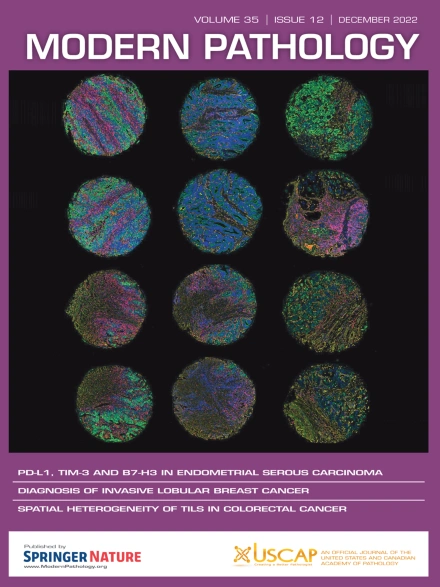乳腺癌免疫生物标志物的数字化分析:与蒽环类药物疗效的关系
IF 7.1
1区 医学
Q1 PATHOLOGY
引用次数: 0
摘要
肿瘤免疫微环境的评估可以作为提高生存率的预后工具和治疗效果的预测性生物标志物,特别是免疫调节治疗包括细胞毒性化疗。利用数字空间分析(DSP)技术,对522例乳腺癌患者的肿瘤免疫微环境进行了研究,对来自MA.5 III期临床试验的35种免疫生物标志物进行了定量分析。在这项试验中,淋巴结阳性乳腺癌患者被随机分配接受非蒽环类化疗(CMF)或含蒽环类细胞毒性化疗(CEF)。根据国际指南,对供体阻断苏木精和伊红(H&E)染色切片进行间质肿瘤浸润淋巴细胞(stil)水平评分。我们假设,通过DSP或H&E染色评估的肿瘤免疫浸润水平较高的患者将比免疫浸润水平较低的患者更受益于CEF(相对于CMF)。数字评分生物标志物的无监督分层聚类显示了两个患者簇:免疫浸润vs忽视。根据预先制定的符合ReMARK指南的统计计划,我们发现与CMF相比,dsp衍生的免疫集群分配并不能预测接受CEF的患者10年无复发生存率的提高。然而,一个次要假设显示,在整个队列和her2富集亚组中,全面切片评估的h&e - stil对CEF的获益比CMF有显著的预测价值。作为探索性分析,DSP评分生物标志物的监督聚类表明,低水平的TIM-3和高水平的HLA-DR和PD-L1与CEF敏感性相关。尽管新的高plex技术提供了对肿瘤微环境的详细了解,但传统的H&E染色仍然是一种强大的工具,可以应用于全面切片来评估免疫微环境的价值,特别是stil,在预测免疫原性化疗的益处方面。本文章由计算机程序翻译,如有差异,请以英文原文为准。
Digital Profiling of Immune Biomarkers in Breast Cancer: Relation to Anthracycline Benefit
Assessment of the tumor-immune microenvironment can be used as a prognostic tool for improved survival and as a predictive biomarker for treatment benefit, particularly from immune-modulating treatments including cytotoxic chemotherapy. Using digital spatial profiling (DSP), we studied the tumor-immune microenvironment of 522 breast cancer cases by quantifying 35 immune biomarkers on tissue microarrays from the MA.5 phase III clinical trial. In this trial, node-positive breast cancer patients were randomized to receive either non-anthracycline chemotherapy (cyclophosphamide, methotrexate, 5’-fluorouracil [CMF]) or anthracycline-containing cytotoxic chemotherapy (CEF). Donor block hematoxylin and eosin (H&E)-stained sections were scored for the level of stromal tumor-infiltrating lymphocytes (sTILs), according to the international guidelines. We hypothesized that patients with higher levels of tumor-immune infiltration, assessed by either DSP or H&E staining, would benefit from CEF (relative to CMF) more than patients with lower immune infiltration. Unsupervised hierarchical clustering of digitally scored biomarkers revealed 2 patient clusters: immune infiltrated versus ignored. Following a prespecified statistical plan crafted to meet REMARK (REporting recommendations for tumor MARKer prognostic studies) guidelines, we found that the DSP-derived Immune Cluster assignment did not predict an improved 10-year relapse-free survival for patients receiving CEF compared with CMF. However, a secondary hypothesis revealed a significant predictive value for H&E sTILs assessed on full-faced sections for CEF benefit over CMF in the entire cohort and the human epidermal growth factor receptor 2-enriched subset. As exploratory analyses, supervised clustering of DSP-scored biomarkers suggested that low levels of T-cell immunoglobulin and mucin domain 3 TIM-3 and high levels of human leukocyte antigen HLA-DR and programmed cell death protein ligand PD-L-1 are associated with sensitivity to CEF. Although novel high-plex techniques provide a detailed insight into the tumor microenvironment, conventional H&E staining remains a powerful tool that can be applied to full-faced sections to assess the value of the immune microenvironment, particularly sTILs, in predicting benefits from immunogenic chemotherapies.
求助全文
通过发布文献求助,成功后即可免费获取论文全文。
去求助
来源期刊

Modern Pathology
医学-病理学
CiteScore
14.30
自引率
2.70%
发文量
174
审稿时长
18 days
期刊介绍:
Modern Pathology, an international journal under the ownership of The United States & Canadian Academy of Pathology (USCAP), serves as an authoritative platform for publishing top-tier clinical and translational research studies in pathology.
Original manuscripts are the primary focus of Modern Pathology, complemented by impactful editorials, reviews, and practice guidelines covering all facets of precision diagnostics in human pathology. The journal's scope includes advancements in molecular diagnostics and genomic classifications of diseases, breakthroughs in immune-oncology, computational science, applied bioinformatics, and digital pathology.
 求助内容:
求助内容: 应助结果提醒方式:
应助结果提醒方式:


